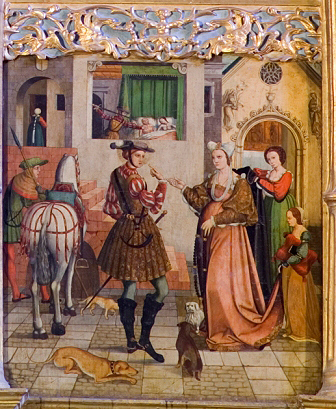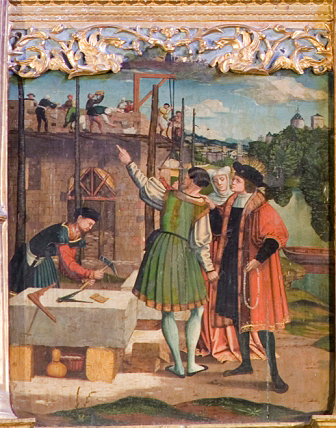The piece of the month of September 2012
SCENES OF DAILY LIFE IN A 16TH CENTURY PICTORIAL ALTARPIECE
María Josefa Tarifa Castilla
University of Zaragoza
The main altarpiece of the parish of San Julián de Ororbia is the first great pictorial work of the Renaissance in Navarre, undertaken in the middle years of the 1520s by a painter who is still unidentified and known as the Master of Ororbia. An artist whose painting evolves between the Hispano-Flemish Gothic tradition -which is manifested in the artist's inclination for small details, the meticulousness with which he works all the elements of the composition, especially the landscapes-, and the new Italian Renaissance trends, which lead him to depict scenes with a very careful and balanced composition, with a study of perspective and framing architectures.
The altarpiece was erected under the title of San Julián Hospitalario, in which together with paintings of religious themes, as was usual at the time, there are others that reproduce scenes of everyday life, something atypical, specifically in the tables of the first body that tell the story of San Julián, inspired by the Golden Legend of Jacobo de la Vorágine, a Genoese Dominican of the thirteenth century. San Julián was a young nobleman, who one day went hunting and had the well-known episode of the meeting with the deer, who revealed to him that he would soon murder his parents. agdalena, one of the greatest exponents of historicism and architectural eclecticism in Spain. With a polygonal plan and a surface of 9 x meters, it was elevated on a platform of ashlar stone with a staircase of the same material; in its execution it would be used cut wood and zinc cover, with a polychrome of gray color, and its cost was estimated at 24,000 reals, amount that could be reduced to 18,500 depending on the materials.This moment is the one depicted in the first painting of the altarpiece dedicated to the patron, in which the boy is practicing this hunting activity, one of the favorite occupations of the aristocrats, a composition inspired graphically and in part by the engraving of The Conversion of Saint Eustace (1501-1502) by Albrecht Dürer, as Buendía pointed out. St. Julian rides on a white horse, dressed in his riding clothes, with a gold-colored sackcloth short to the knees, over which hangs the horn, gray breeches, black boots tight to the calves and gray hat fastened to the neck, clothing in accordance with the fashion of the early decades of the sixteenth century. The painter situates the scene in the middle of a green forest, lands that probably belong to the domains of this aristocratic family, being accompanied in this activity of amusement by several greyhound dogs that harass the deer and two servants, one of which sounds the horn. At the bottom of the panel, a path is drawn leading to a castle with thick square towers built on top of the hill, the dwelling of the high-born character.

High altarpiece of the parish of San Julián de Ororbia. Deer hunting
The following table, which reproduces the tragic episode of St. Julian killing his parents, is again a recreation of daily life, in which two chronological moments follow one another. Saint Julian, fearing that the prophecy of the deer would be fulfilled, abandons his parents and goes far away to another country, marrying a lady of high social rank. One day he had gone out hunting, which is why he is depicted in the painting with the same attire as in the previous episode, when he arrived home and found in his room a couple, who were his parents. The young man kills his parents with his sword, mistakenly believing that his wife was committing adultery. The painter recreates the interior of the stately home, distributed in different rooms, from the bedroom itself, whose bed is covered with green fabrics, to other rooms through which a maid passes, drawing on the arch of entrance to the house the coat of arms of the owners, which tells us of the high lineage of the people who live there. After committing the crime, San Julián goes out to the street, where at the entrance of his palace, in front of the access stairs to it, his squire awaits him holding the white steed, accompanied by the hunting dogs, the painter manages to provide depth to the scene by means of the tiling of the street and the open windows of the mansion.
At that precise moment San Julián is with his wife, who accompanied by two maids returns after having gone to the celebration of the divine offices, as befits the people of his social class , inserted in a sacralized society in which religion marks the rhythm of life. That is why on the right side of the painting the painter recreates the facade of the church, which he treats in detail, with the scenes on the front of the Annunciation through the figures of St. Gabriel and the Virgin Mary. Even the door of the church remains open, and we can glimpse the liturgical ornamentation of the same, with a sculptural altarpiece that presides over the altar. Curiously, next to the lady, who wears a rich garment to differentiate her from the rest of the women, there is a water dog, surely as a clear allusion to conjugal fidelity, since this dog subject usually appears in paintings of matrimonial themes and in cases in which the purity of conjugal love is alluded to.

High altarpiece of the parish of San Julián de Ororbia. San Julián giving death to his parents
The third painting, which represents Saint Julian visiting the construction site of the hospital that he himself ordered to be built for pedestrians, as penance for his horrendous crime, is the perfect excuse for the painter to capture with great reality the construction process of a building at the beginning of the 16th century. Thus, in the foreground, at the foot of the building site, the clients appear, who attentively follow the process of the Building process of the welfare center under the explanation of the architect, recognizable because he holds the compass in his hands, in allusion to his high social consideration, not as a simple craftsman, but as an intellectual who knows how to draw the layout of the building, but of an intellectual who knows how to draw, to design, with the square and compass that he has left on the stone ashlar, as expressed in the treatises on artistic theory of the Renaissance, from the Italians such as Alberti in his De re aedificatoria, to the Spanish Diego de Sagredo graduate Medidas del Romano (Toledo, 1526). Next to him appears the stonemason, an expert in stone carving, roughing and carving the ashlar, under which he has kept the gourd to keep the drink and the basket with the food fresh.
In the background, nine officials appear at work on wooden scaffolding built with tree trunks and embedded in the walls. Some are placing ashlars, others are applying the mortar with the trowel, another is working the crane to hoist the materials and there is even one who is quenching his thirst with a flat bottle with a circular body. The painter also pays attention to the falsework used to make the semicircular arch through which the interior of the building is accessed, a wooden structure that has not yet been removed.
In final, through the pictorial representation of episodes from the life of a saint, Saint Julian Hospitaller, the Master of Ororbia recreates with great technical skill and historical fidelity the daily occupations of the men who lived in the sixteenth century. The different scenes show from the occupations of the privileged classes, such as the nobility, whose privileged status allowed them to spend their time hunting, not for food, but for entertainment; the daily attendance to the celebration of the divine offices, in the case of the highborn lady accompanied by the servants; to the existing professional hierarchy in the construction trades, from the architect who directs the Building, to the different officers who work on the site with the laborers.

High altarpiece of the parish of San Julián de Ororbia. San Julián visiting the works of the hospital
bibliography
-ÁNGULO ÍÑIGUEZ, D., "La pintura del Renacimiento en Navarra", Príncipe de Viana, t. IV, nº 13, Pamplona, 1943, pp. 421-444.
-BUENDÍA, J.R., "Pintura" in Historia del Arte Hispánico, III. The Renaissance, Madrid, Alhambra, 1988, pp. 250-251.
-ECHEVERRÍA GOÑI, P.L., "El taller pictórico de Pamplona en el siglo XVI", El arte en Navarra. 2- Renaissance, Baroque and from Neoclassicism to current art, Pamplona, Diario de Navarra, 1994, pp. 337-352.
-FERNÁNDEZ GRACIA, R. (coord.), ECHEVERRÍA GOÑI, P.L. and GARCÍA GAINZA, M.C., El arte del Renacimiento en Navarra, Pamplona, Gobierno de Navarra, 2005, pp. 303-304.
VORÁGINE, S. DE LA, La Leyenda Dorada, I, Madrid, Alianza, 1982.
